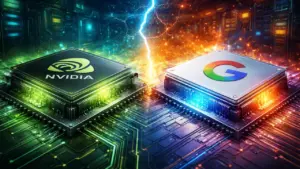Introduction: The Quantum Bombshell
Microsoft just did something that could change the future of computing forever. After nearly two decades of research, they claim to have created a particle once thought to exist only in theory. This particle, the Majorana, is now the foundation of their new quantum chip: the Majorana 1.
This isn’t just another tech upgrade. This chip could hold a million qubits on a chip small enough to fit in your hand. Compare that to today’s quantum computers, which struggle to manage just a few hundred qubits. The implications? Solving problems so complex, they would take every classical computer in the world longer than the age of the universe to compute.
This is not hype. It’s math.
Two Decades in the Making
Microsoft has been quietly working on this for over 20 years. It’s the longest-running research program in the company’s history. Their goal? Find a particle predicted by theory but never confirmed in nature: the Majorana zero mode.
Their persistence paid off. In 2023, Microsoft scientists observed the Majorana particle for the first time. This year, they announced something even bigger: not only can they detect the particle, they can now control it.
This marks a massive leap from theory to application. With this discovery, Microsoft hasn’t just added to quantum computing. They may have redefined it entirely.
What Is the Majorana Particle?
Named after Italian physicist Ettore Majorana, the Majorana particle has a unique property. It is its own antiparticle. In simple terms, when a Majorana particle meets itself, it doesn’t annihilate like other particles. Instead, it behaves in a stable and predictable way.
For decades, physicists believed that if we could find and use this particle, we could build quantum computers that are far more stable and scalable. Unlike traditional qubits, which are fragile and error-prone, Majorana-based qubits could be topologically protected. That means fewer errors and longer coherence times.
This makes the Majorana particle ideal for building a reliable, scalable quantum system.
From Theory to Reality
The shift from theoretical physics to working hardware is rare and remarkable. In 2023, Microsoft confirmed the first observation of the Majorana particle in their labs. Now, in 2025, they say they can control it.
This led to the creation of a new state of matter: the topoconductor. It’s not just a better conductor; it’s a new kind of quantum material. The topoconductor allows the Majorana particle to exist and operate in a stable form, which is key to building the Majorana 1 chip.
This isn’t a tweak to existing quantum systems. It’s an entirely new approach. It bypasses many of the problems faced by current quantum systems, such as decoherence and noise.
With topoconductors, Microsoft has built a platform that could scale quantum computing in ways never seen before.
The Power of the Majorana 1 Chip
The Majorana 1 chip promises something no other company has achieved: a million qubits on a single chip. Today’s top quantum processors manage around 50 to 100 usable qubits. These systems are bulky, fragile, and require extreme conditions to operate.
With the Majorana 1, Microsoft says you can achieve quantum supremacy in a much smaller, more robust form. The chip fits in your hand, yet has computing power that could outpace every classical computer on Earth.
This isn’t science fiction. It’s the beginning of practical, scalable quantum computing.
Imagine breakthroughs in:
- Drug discovery
- Climate modeling
- Cryptography
- Financial forecasting
- Artificial intelligence
Problems that were once out of reach could become solvable in seconds. This chip could redefine what’s possible across industries.
What This Means for the Future
Microsoft has not given a specific release date for commercial deployment. But the technology is real, and the roadmap is clear. They’ve already partnered with leading universities, labs, and government agencies to explore use cases.
This could mark the start of the quantum economy. Just as classical computing created the digital revolution, quantum could bring about the next wave of global innovation.

Other companies like IBM and Google are also in the quantum race. But Microsoft’s approach stands out because it’s foundational. Instead of trying to scale fragile qubits, they’ve changed the entire blueprint.
That gives them a strong edge.
Conclusion: The Quantum Race Just Got Real
With the Majorana 1 chip, Microsoft has taken a huge leap forward. They didn’t just improve existing tech; they reinvented the quantum model. From discovering a theoretical particle to building a working chip that could handle a million qubits, this is historic.
The impact of this development is hard to overstate. We could soon solve problems previously considered impossible. A new era of computing is beginning.
For tech enthusiasts, developers, and entrepreneurs, this is your signal to pay attention. The quantum future is now.
Stay tuned with StartupHakk as we continue to cover the innovations that shape tomorrow. Because if Microsoft is right, we just witnessed the start of something truly revolutionary.




